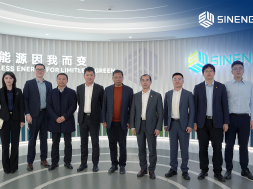
Tesla reveals more details about its plan to create ‘world’s only integrated sustainable energy company’
While anyone with a few dollars (~$200 for Tesla and ~$20 for SolarCity) can hold shares and vote on the merger between Tesla and SolarCity, the institutional shareholders are really the only ones who can make a difference and tip the scale.
Now Tesla put together a presentation and set out to convince its institutional shareholders to vote for the merger. In the presentation, Tesla reveals a few more interesting details about its plan to create what it calls the “world’s only integrated sustainable energy company”.
Here we put together a few highlights from the presentation:
The company describes the “world’s only integrated sustainable energy company” as a “vertically integrated energy company offering end-to-end clean energy products.” In my piece ‘Tesla integration of home charging station + energy storage + solar will change everything‘, I explained that Tesla is trying to own the entire energy sector from generation through solar installations to consumption with its electric vehicles.
In the new presentation, Tesla confirmed that it plans to phase out SolarCity’s brand throughout the next year. It’s something that we suspected since the company filed for trademarks to sell solar products under its ‘Tesla Brand’.
In a slide called ‘Roadmap to Successful Integration’, the company made it clear that ‘Tesla’ will be the sole brand of the company and that all employees of the new combined company will be ‘Tesla employees’:
Over the course of 2017 the combined company will transition to operate as one company under Tesla name
Tesla will have 3 products sold and marketed under the Tesla brand- Autos, Batteries, and Solar
All employees will be Tesla employees supporting Tesla’s three products
It raises the question of role overlaps between the two companies after the merger. Tesla also addressed that in the presentation. The company says that it will “leverage SolarCity’s existing installer network, customer support and service infrastructure, and solar engineering and construction capabilities. But Tesla also confirmed that it will “remove duplication in sales and general & administrative functions.”
Tesla also sees an opportunity to combine software engineering teams to develop applications together:
“As separate entities, Tesla and SolarCity are each developing their own customer apps, Powerwall aggregation software, and Powerpack control algorithms. Post-acquisition, there will be a single engineering team working to develop a single suite of seamlessly integrated products.”
Maybe we can expect a single application that will enable customers to monitor their energy generation through a solar roof, energy storage with the Powerwall, and charging through the new ‘Tesla charger’ and a Tesla vehicle.
Tesla expects that it will be able to reduce the cost of the entire energy offering through the integration of all the products and energy solutions.
There are two recurring points in the presentation that Tesla is trying to convey to investors. One is that the company sees a great opportunity for combining Tesla’s engineering and design teams with SolarCity’s, and now Panasonic’s manufacturing expertise, to create aesthetically pleasing solar panels and solar roofing solutions that are more compelling to customers.
The second point that often comes up is Tesla’s plan to leverage SolarCity’s many teams of installers, the company employs thousands of installers, in order to expand their range of products that they can install to Powerwalls and charging systems.











